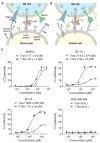Enzymes as Immunotherapeutics
- PMID: 29285931
- PMCID: PMC5993548
- DOI: 10.1021/acs.bioconjchem.7b00719
Enzymes as Immunotherapeutics
Abstract
Enzymes are attractive as immunotherapeutics because they can catalyze shifts in the local availability of immunostimulatory and immunosuppressive signals. Clinical success of enzyme immunotherapeutics frequently hinges upon achieving sustained biocatalysis over relevant time scales. The time scale and location of biocatalysis are often dictated by the location of the substrate. For example, therapeutic enzymes that convert substrates distributed systemically are typically designed to have a long half-life in circulation, whereas enzymes that convert substrates localized to a specific tissue or cell population can be more effective when designed to accumulate at the target site. This Topical Review surveys approaches to improve enzyme immunotherapeutic efficacy via chemical modification, encapsulation, and immobilization that increases enzyme accumulation at target sites or extends enzyme half-life in circulation. Examples provided illustrate "replacement therapies" to restore deficient enzyme function, as well as "enhancement therapies" that augment native enzyme function via supraphysiologic doses. Existing FDA-approved enzyme immunotherapies are highlighted, followed by discussion of emerging experimental strategies such as those designed to enhance antitumor immunity or resolve inflammation.
Figures




Similar articles
-
The role of antibodies in enzyme treatments and therapeutic strategies.Best Pract Res Clin Endocrinol Metab. 2015 Mar;29(2):183-94. doi: 10.1016/j.beem.2015.01.006. Epub 2015 Jan 24. Best Pract Res Clin Endocrinol Metab. 2015. PMID: 25987172 Review.
-
[Gene therapy of Gaucher's and Fabry's diseases: current status and prospects].J Soc Biol. 2002;196(2):175-81. J Soc Biol. 2002. PMID: 12360746 Review. French.
-
Gaucher and Fabry diseases: from understanding pathophysiology to rational therapies.Acta Paediatr Suppl. 2003 Dec;92(443):19-24. doi: 10.1111/j.1651-2227.2003.tb00215.x. Acta Paediatr Suppl. 2003. PMID: 14989461
-
Enzyme Replacement Therapy for Lysosomal Storage Diseases.J Infus Nurs. 2020 Sep/Oct;43(5):243-245. doi: 10.1097/NAN.0000000000000390. J Infus Nurs. 2020. PMID: 32881810 No abstract available.
-
Current enzyme replacement therapy for the treatment of lysosomal storage diseases.Pediatr Ann. 2009 Aug;38(8):448-55. doi: 10.3928/00904481-20090723-09. Pediatr Ann. 2009. PMID: 19725195 Review. No abstract available.
Cited by
-
Production and Purification of Therapeutic Enzymes.Adv Exp Med Biol. 2019;1148:1-24. doi: 10.1007/978-981-13-7709-9_1. Adv Exp Med Biol. 2019. PMID: 31482492 Review.
-
Combining a Genetically Engineered Oxidase with Hydrogen-Bonded Organic Frameworks (HOFs) for Highly Efficient Biocomposites.Angew Chem Int Ed Engl. 2022 Apr 11;61(16):e202117345. doi: 10.1002/anie.202117345. Epub 2022 Feb 24. Angew Chem Int Ed Engl. 2022. PMID: 35038217 Free PMC article.
-
A Randomized Controlled Trial of the Efficacy of Systemic Enzymes and Probiotics in the Resolution of Post-COVID Fatigue.Medicines (Basel). 2021 Aug 30;8(9):47. doi: 10.3390/medicines8090047. Medicines (Basel). 2021. PMID: 34564089 Free PMC article.
-
Redox responsive activity regulation in exceptionally stable supramolecular assembly and co-assembly of a protein.Chem Sci. 2020 Nov 17;12(3):1101-1108. doi: 10.1039/d0sc05312k. Chem Sci. 2020. PMID: 34163877 Free PMC article.
-
Locally anchoring enzymes to tissues via extracellular glycan recognition.Nat Commun. 2018 Nov 22;9(1):4943. doi: 10.1038/s41467-018-07129-6. Nat Commun. 2018. PMID: 30467349 Free PMC article.
References
-
- Kjeldsen L, Sengelov H, Lollike K, Nielsen MH, Borregaard N. Isolation and characterization of gelatinase granules from human neutrophils. Blood. 1994;83:1640–1649. - PubMed
-
- Faurschou M, Sørensen OE, Johnsen AH, Askaa J, Borregaard N. Defensin-rich granules of human neutrophils: characterization of secretory properties. Biochim Biophys Acta, Mol Cell Res. 2002;1591:29–35. - PubMed
-
- Jones JA, McNally AK, Chang DT, Qin LA, Meyerson H, Colton E, Kwon ILK, Matsuda T, Anderson JM. Matrix metalloproteinases and their inhibitors in the foreign body reaction on biomaterials. J Biomed Mater Res, Part A. 2008;84A:158–166. - PubMed
-
- Modolell M, Corraliza IM, Link F, Soler G, Eichmann K. Reciprocal regulation of the nitric oxide synthase/arginase balance in mouse bone marrow-derived macrophages by TH 1 and TH 2 cytokines. Eur J Immunol. 1995;25:1101–1104. - PubMed
-
- Haroon ZA, Hettasch JM, Lai TS, Dewhirst MW, Greenberg CS. Tissue transglutaminase is expressed, active, and directly involved in rat dermal wound healing and angiogenesis. FASEB J. 1999;13:1787–1795. - PubMed
Publication types
MeSH terms
Substances
Grants and funding
LinkOut - more resources
Full Text Sources
Other Literature Sources

